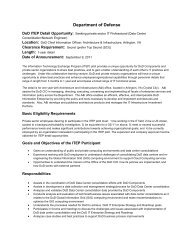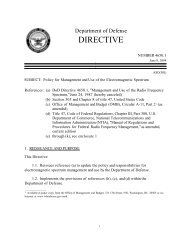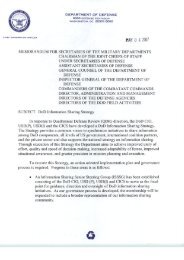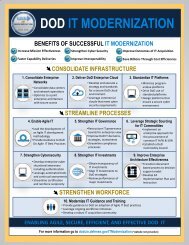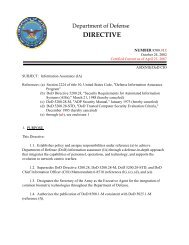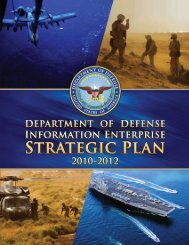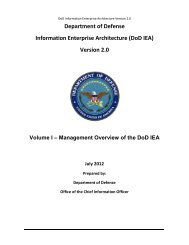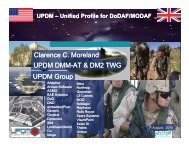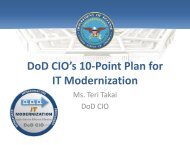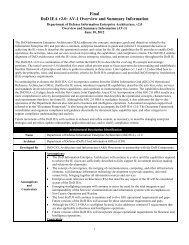DoD Architecture Framework Version 1.5 - Chief Information Officer
DoD Architecture Framework Version 1.5 - Chief Information Officer
DoD Architecture Framework Version 1.5 - Chief Information Officer
Create successful ePaper yourself
Turn your PDF publications into a flip-book with our unique Google optimized e-Paper software.
enables the incorporation of information in portfolio and enterprise overarching architectures for<br />
a more complete view of the organization. Figure 1-3 represents the information that links the<br />
operational view, systems and services view, and technical standards view. The three views and<br />
their interrelationships driven – by common architecture data elements – provide the basis for<br />
deriving measures such as interoperability or performance, and for measuring the impact of the<br />
values of these metrics on operational mission and task effectiveness.<br />
All-View<br />
Describes the Scope and Context (Vocabulary) of the <strong>Architecture</strong><br />
• What Needs to Be Done<br />
• Who Does It<br />
• <strong>Information</strong> Exchanges<br />
Required to Get It Done<br />
• Systems and Services<br />
that Support the<br />
Activities and<br />
<strong>Information</strong> Exchanges<br />
Systems and Services<br />
View<br />
Relates Systems, Services,<br />
and Characteristics to<br />
Operational Needs<br />
Operational<br />
View<br />
Identifies What Needs to be<br />
Accomplished and Who Does It<br />
• Specific System Capabilities<br />
Required to Satisfy <strong>Information</strong><br />
Exchanges<br />
• Technical Standards Criteria<br />
Governing Interoperable<br />
Implementation/Procurement of<br />
the Selected System Capabilities<br />
Technical Standards<br />
View<br />
Prescribes Standards and<br />
Conventions<br />
Figure 1-3: Linkages Among Views<br />
<strong>DoD</strong>AF's data layer is captured in the CADM, which was developed to support the data<br />
requirements of the <strong>DoD</strong>AF. The CADM defines the entities and relationships for <strong>DoD</strong>AF<br />
architecture data elements that enable integration within and across architecture descriptions. In<br />
this manner, the CADM supports the exchange of architecture information among Mission<br />
Areas, Components, and Federal and Coalition partners, thus facilitating the data interoperability<br />
of architectures.<br />
The <strong>DoD</strong>AF defines a set of products that act as mechanisms for visualizing, understanding,<br />
and assimilating the broad scope and complexities of an architecture description through graphic,<br />
tabular, or textual means. These products are organized under four views: OV, SV, TV, and All-<br />
View (AV). Each view depicts certain perspectives of an architecture as described below.<br />
1.4.2 Definition of the Operational View<br />
The OV captures the operational nodes, the tasks or activities performed, and the information<br />
that must be exchanged to accomplish <strong>DoD</strong> missions. It conveys the types of information<br />
exchanged, the frequency of exchange, which tasks and activities are supported by the<br />
information exchanges, and the nature of information exchanges.<br />
1.4.3 Definition of the Systems and Services View<br />
The SV captures system, service, and interconnection functionality providing for, or<br />
supporting, operational activities. <strong>DoD</strong> processes include warfighting, business, intelligence, and<br />
infrastructure functions. The SV system functions and services resources and components may<br />
be linked to the architecture artifacts in the OV. These system functions and service resources<br />
1-8




